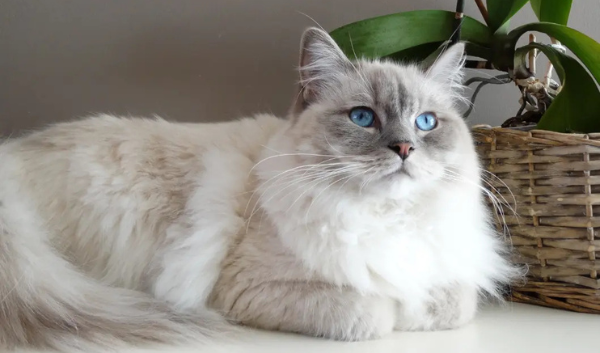Ragdoll Cat Breed Guide: Everything NZ Cat Owners Need to Know
Ragdolls are one of the most beloved cat breeds in New Zealand, cherished for their affectionate nature, calm temperament, and stunning blue eyes. If you’re considering welcoming a Ragdoll into your home—or already have one—this guide covers everything you need to know. From feeding and grooming to behaviour and parasite control, this is your ultimate NZ-specific resource.
Breed Origins & History
The Ragdoll breed was developed in the 1960s in California by breeder Ann Baker. They’re believed to be a mix of Persian, Birman, and domestic longhair cats. Their name comes from their unique tendency to go limp and relaxed when picked up, much like a ragdoll.
Ragdolls arrived in New Zealand in the late 1980s and have since become one of the most popular pedigree breeds due to their affectionate, people-loving nature.
Appearance & Physical Traits
Coat: Semi-long, silky, and non-matting
Eyes: Always blue, almond-shaped
Size: Large and muscular (males: 6–9kg, females: 4–6kg)
Colour Patterns: Seal, blue, chocolate, lilac, and cream; with point, mitted, and bicolour variations
Ragdolls are slow to mature and don’t reach full size or coat development until around 3–4 years old.
Personality & Temperament
Ragdolls are famously gentle, friendly, and social. They thrive on human interaction and often follow their owners around the house. Unlike some independent cat breeds, Ragdolls prefer to be close to their people and are often described as "puppy-like."
Great with children and other pets
Rarely aggressive
Adapt well to indoor-only living
Enjoys lap time and interactive play
They are not overly vocal but will meow softly to communicate.
Ideal Environment
Ragdolls are best suited to indoor or enclosed outdoor environments (catios), where they are protected from cars, predators, and diseases. They do not possess strong street smarts or survival instincts.
Soft bedding and window perches are ideal
Vertical climbing options (cat trees, shelves)
Toys and daily human interaction
Because of their laid-back nature, Ragdolls adapt well to apartments, family homes, and even households with dogs.
Feeding & Nutrition
Ragdolls are large cats that require a balanced diet to maintain a healthy weight and support muscle mass.
Kitten (up to 12 months): Royal Canin Ragdoll Kitten, Pro Plan Kitten, or a high-protein wet food
Adult (1–7 years): Royal Canin Ragdoll Adult, Feline Natural Lamb & Chicken, or Ziwi Peak Air-Dried Chicken
Senior (7+): Switch to senior-specific foods with joint support and reduced fat
Feeding tip: Portion control is essential as Ragdolls are prone to obesity if overfed. Consider using puzzle feeders to slow down eating.
Grooming & Coat Care
Despite their long coats, Ragdolls require relatively low grooming compared to other long-haired breeds:
Brush 2–3 times per week to remove loose hairs and prevent tangles
Use a stainless steel comb or slicker brush
Check behind ears, under legs, and around the neck
Bathing is rarely necessary
During seasonal shedding (autumn/spring), increase brushing to prevent hairballs.
Health Considerations
Ragdolls are generally healthy, but like all breeds, they can be predisposed to certain genetic conditions:
Hypertrophic Cardiomyopathy (HCM): A common heart condition; ensure breeding cats are screened
Bladder stones: Encourage hydration and a high-moisture diet
Obesity: Controlled through diet and activity
Routine vet checkups, vaccinations, and dental care are crucial.
Flea & Worm Treatment in NZ
For optimal health, Ragdolls (like all cats in NZ) should follow a strict parasite prevention schedule:
Fleas: - Year-round prevention recommended - Use monthly treatments like Bravecto Plus, NexGard Spectra, or Advantage for Cats
Worms: - Treat every 3 months with a broad-spectrum wormer like Endogard, Profender, or Milbemax
Tip: Use a calendar reminder or subscribe to an auto-ship schedule through PetSupply.co.nz.
Exercise & Enrichment
While not hyperactive, Ragdoll's benefit from daily enrichment to maintain muscle tone and prevent boredom.
Wand toys, laser pointers, and puzzle feeders
Climbing structures and hideouts
Short daily play sessions (10–15 minutes)
They enjoy routine and human interaction more than solitary play.
Socialisation & Interaction
Ragdolls are one of the most social breeds. They’re often called "floppy cats" because of their relaxed attitude.
They enjoy meeting new people
Do well in multi-pet households
Crave human affection but not overly demanding
They may not enjoy being left alone for long hours every day. Consider a second cat or pet for company.
Is a Ragdoll Right for You?
✅ Best for indoor households with loving, consistent human contact
✅ Great for families, retirees, and those seeking a calm companion
✅ Requires moderate grooming and a high-quality diet
❌ Not ideal for those wanting an aloof or highly independent cat
Final Thoughts
The Ragdoll is a gentle giant with a heart of gold. Whether you’re a seasoned cat owner or new to feline companionship, this breed offers unconditional affection, beauty, and loyalty.
For all your Ragdoll care essentials, explore our full range at PetSupply.co.nz — where happy, healthy cats begin.

